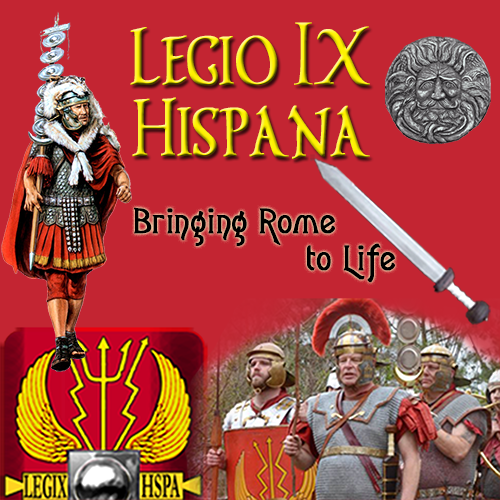Footwear
We suggest getting a good set of Roman footwear — this isn't a place to "go cheap", since you are going to be spending a lot of time standing and marching. Having footwear that is broken in and adjusted to your feet can prevent a lot of misery at your first event. You can make your own caligae at unit workshops, or buy a commercially manufactured pair from the unit source list. Calcei can be custom ordered from a few vendors in Europe — a realy good one is on Etsy and is from the Czech Republic!
(caligae or calcei)
 The heavy sandals known
as caliga (pl. caligae) are the classic Roman army boot. Numerous examples
have been found at first-century sites. When most people think of the Roman Army, they think of them wearing caligae. Also
worn, were calcei (pl. of calceus) a more enclosed type of boot worn in colder climates
such as Britain or Germany.
The heavy sandals known
as caliga (pl. caligae) are the classic Roman army boot. Numerous examples
have been found at first-century sites. When most people think of the Roman Army, they think of them wearing caligae. Also
worn, were calcei (pl. of calceus) a more enclosed type of boot worn in colder climates
such as Britain or Germany.

Since everybody has a unique set of feet you can do one of three things: Make your own, have someone make them for you, or buy a "manufactured" pair. If you wish to make your own, the unit has patterns. If you want a custom-made pair you can look to someone who makes them, but these cost a lot more.
Caligae
Construction involves a lot of careful cutting but is otherwise straightforward. The upper is cut from a
single piece of c. 8-ounce leather, well-oiled (with neatsfoot oil) to prevent decay.
Cutting away the slots in each tab and the spaces between them actually removes most of the leather. On a
good caliga there should be more space than leather, making it seem very open. Since the leather is quite
thick, strength should not be a problem, and in fact, leaving too much leather can make it less flexible and prone to chafing.
The caliga is comprised of three elements: the upper, the outer sole, and the inner sole. The upper is one piece. The outer sole might be made of one, two or three layers of leather and this depends upon your preferences.
The inner sole is usually one layer of leather sometimes two used to protect the foot from the ends of the hobnails. In addition we recognize that we have modern feet therefore it is allowable to use modern insoles, arch supports and orthotics so long as they are hidden.
< (photo courtesy of www.ledermuseum.de)
- Making Authentic Caligae — A GREAT article on how to make really accurate caligae.
- Legio XX's Caligae page—Legio XX has some good articles on how to make these.
- Caligae — Another super great site really showing how caligae should look. Skinny straps and not the modern farby reenactor style with really fat straps—LOOK at photos of the REAL thing... A good example is this photo to the left... notice how skinny the straps are, in contrast with the standard reenactor pair that most end up wearing.
Calcei
 Calcei are shoes that covered the whole foot, as distinguished from a sandal, or
soleae. These are generally considered to be the center seamed or laced shoes with the separate
inner and outer soles.
Calcei are shoes that covered the whole foot, as distinguished from a sandal, or
soleae. These are generally considered to be the center seamed or laced shoes with the separate
inner and outer soles.
(From our comrade at Roman Recruit):
From the late 1st
century onwards the army began to equip itself with calcei, an enclosed boot more often used by
civilian workers. This transition may reflect the fact that more recruits were coming from the
northern frontiers, where enclosed boots are of great benefit, or it might reflect changes in the
supply system, with legions turning to civilian sources for their footwear.
Whatever the
reason, calcei were ubiquitous in the British provinces. At Vindolanda, the wet conditions have
preserved many examples of Roman footwear, civilian and military, adult and child. A great
proportion (of all types) have hobnails hammered into the soles, a technique which binds the thick
soles strongly together, which reduces wear and tear, and which gives an excellent grip akin to
wearing modern football boots!
- Roman Recruit — This site has TONS of good info, on many subjects. The owner actually wears his stuff a lot and has some great insights. Give it a look.
- Mainz Calceus — A good article on this type of calceus.
- Vindolanda Calceus — An article from the site above that shows this pattern.
- Florentius — One of the best, for last. He really shows how to make stuff! A true artist.
Here is a well-worn pair of calcei used by our friend Gaius Fortunatus at Roman Recruit.













